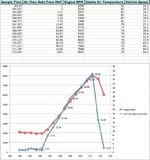StevenH72 said:
If the Air Flow Rate is a function of density, do IATs need to be taken into consideration when considering the changes between plugging and not plugging?
Some of the examples, whilst showing higher flow rates, also show IATs as being lower....surely you'd need to standardise the IATs to create comparable data?
As I stated in the earlier posting above, the DashDyno in Dyno Mode calculates a "standardised" result. This means that you can do a dyno run on a coast road of the Arctic in the middle of winter in high pressure conditions and low humidity, when air density is greatest and directly compare the result with a dyno run done in Mexico City on a steaming hot day and the results will be directly comparable, because the DashDyno does the maths which incorporates air density into the results. I believe the maths also allows for differing aerodynamic drag in different air density conditions.
If you datalog IAT you will soon see that it is never a fixed figure when the ambient temperature remains the same and it is constantly changing so it is impossible to say that when ambient temperature is at, say, 20degs C, the IAT will be at a fixed temperature of, say 28degs C. The IAT will rise when the car stops and will fall when you accelerate and it will even rise during gear changes! However, you can compare IATs with different air-intake configurations and see how close to ambient that you can get the IAT during acceleration. So far, I've found it impossible to get the IAT of the Z4MC closer than 5degs C above ambient temperature with modifications.
For my own purposes, I like to use Volumetric Efficiency as one of the best ways of monitoring performance differences from modifying air-intakes and exhausts and to do this I datalog the following three parameters: 1. Airflow through the MAF, 2. Engine RPM, 3. IAT. I then use the datalog files in .csv format in Excel, in a spreadsheet that I've composed which produces VE figures, line by line. Since the calculation of VE requires IAT, the differences in IAT at any data sample point is "neutralised" in the calculation of VE, thus performance under different conditions can be directly compared this way. I additionally record the vehicle speed with the other 3 parameters, so that I can see the how speed has a dynamic effect on VE because this demonstrates the Ram Effect. Using my methods datalogging shows me whether any modification, helps to lower the IATs and/or increase airflow through the Ram Effect, both of which will increase the VE and give a performance gain.
I am totally objective with modifying and I trust the ECU to give me sufficiently accurate data to show me whether something works or doesn't. I don't pursue lost causes no matter how much time and effort I've invested. I once spent ages partially gutting the cats for a Z3MC and the data logger proved that they were detrimental to performance so they instantly got ditched, even though my butt-dyno couldn't tell any difference.






